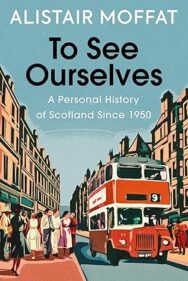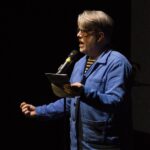‘This confluence of styles – analytical yet elegiac, objective yet personal – makes To See Ourselves a hard book to categorise but an easy book to love.’
David Robinson thoroughly enjoys Alistair Moffat’s personal history of Scotland after the Second World War, a time of massive social change.
To See Ourselves: A Personal History of Scotland Since 1950
By Alistair Moffat
Published by Birlinn
FOR years now, I have been singing the praises of David Kynaston’s gloriously detailed social histories of post-war Britain. So far there have been five books in his series, though they only go up to 1965. If he is to stick to his original plan of chronicling how Britain changed between 1945 and 1979, he’s got his work cut out. He is 73 now, and I desperately hope he has no thoughts of retiring.
What I love about Kynaston’s books is the way in which they pick up on the minutiae of everyday life – the things which slipped by the consciousness of those of us whose childhood began in the years he covers, making sense of news stories whose headlines we might have heard, uncomprehendingly, on the radio before heading out of doors (of course) to play, reminding us of the tiniest changes on the fringes of our lives: the order of flavours in which crisps appeared on the shelves, when striped toothpaste first went on sale, or why cutting bone meal from pet food meant an end to white dog poo on the pavements. Not perhaps what Proust was banging on about, but a retrospective extension of one’s life all the same.
Alistair Moffat’s latest book, To See Ourselves, doesn’t aim to be a Kynaston clone – even though the latter’s histories dominate his Further Reading list. Indeed, the book’s subheading – ‘A Personal History of Scotland since 1950’ – suggests that that if it owes a debt to any other writer, it is to Fintan O’Toole’s 2022 bestseller We Don’t Know Ourselves; A Personal History of Ireland, which also opens in the 1950s and dances with similar panache on the line between memoir and history all the way up to the present.
If this hybrid form is to be a new trend on bookshop shelves, I’d rather welcome it. For even the biggest Kynaston fan has to admit that his very comprehensiveness comes at the cost of occasional longueurs (unless, for example, you are absolutely fascinated by, say, trends in Welsh nonconformism in the 1950s). The very fact that Moffat’s history of modern Scotland is threaded through with his own experience keeps the reader engaged throughout.
It helps, I think, that he has already written a childhood memoir (Homing, 2003), scratching that primal itch every writer must surely feel about recapturing life’s first surprises and trying to explain what growing up felt like. In To See Ourselves, though, communal history is at least as important as his own recollections – like a photograph album in which the background matters just as much as the faces grinning at the camera.
Take, for example, Moffat’s love of rugby. Growing up in 1950s Kelso, it helped that he was good enough to be a replacement prop for the First XV in 1968 while still a 17-year-old. The glow of nostalgia still lingers, for this was a time when heroes were still local, when ‘one in eight Borderers watched, played or otherwise enabled rugby’ and Borders matches could still attract crowds of 10,000. Moffat tells a lovely story from 1958, when Kelso forward Ian Hastie scored his one and only try for Scotland in a 11-9 victory over France at Murrayfield. The next day, as Hastie made his way past the Moffats’ prefab home on his way to his job at Kelso station, he was berated by Moffat’s beloved grandmother Bina, who had watched the match on TV and criticised him for not running under the posts to make the conversion kick easier. ‘Sorry,’ Moffat heard the big prop forward say. ‘Sorry about that, Mistress Moffat.’
Just look at everything contained within that anecdote. Mistress Moffat, because of respect, manners, and that now horribly overworked word ‘community’. Kelso station, because it still existed, and the report on Hastie’s Murrayfield heroics in that Saturday’s Edinburgh Evening News Pink could presumably make the 45-mile journey to the Kelso newsstands even quicker by rail than road (though, in a triumph of logistics, they were always sale there by 6.30pm). Prefab houses, because in 1944 the government planned on building 300,000 of them for returning servicemen, including apparently one type designed specifically to use up the stockpile of scrap aluminium salvaged from the wrecks of bombers and fighter planes. TV, because before it ‘the only non-Scots, even non-Borderers, I knew anything about were cowboys, Indians and Nazis’, and because it was going to change everything.
As director of programmes at Scottish Television, Moffat would subsequently immerse himself in the world of television and come to see how the professionalism and money it brought into sport would ultimately doom localism, transforming the game in Scotland into one which more people wanted to watch than play. ‘Money produces results,’ he notes glumly, ‘and those results are, therefore, more or less predictable.’
The pithiness of that assessment finds plenty of echoes elsewhere in the book, and Moffat’s analysis of the massive social changes in modern Scotland (decline of religion, depopulation of the countryside, the transformation of shopping and the very slowly swinging Sixties) is always astute. And as countryman, townie, festival director, entrepreneur, historian, TV boss and writer of more than 40 highly regarded books, he has a wider frame of reference than most, as well as a good journalist’s nose for what matters.
Yet there’s no bombast here: Moffat knows exactly how lucky he has been, how much he profited from that great boomer blessing – the Anderson report of 1960, which opened up the possibility of a university education to thousands of working-class Scots by recommending the provision of tuition fees and grants for living expenses while they studied for their first degree. Along with the Robbins report creating more universities, it was implemented in time for Moffat to start his studies at St Andrews in 1968. As he points out, though, the good times didn’t last: ‘It was the beginning of a brief window in history, one that remained open for less than 20 years, a time when there was no bar to educational advancement for young people with ability.’
To See Ourselves taught me much that I didn’t know (for example, that the 1973 Clayson Report transforming Scottish licensing hours originally recommended that children should be allowed in pubs); things I should have known (that before the Thatcher reforms proportionately twice as many Scots than English lived in council housing); things I’d forgotten (that once shops wouldn’t dare sell skimmed milk); and things I just don’t remember at all (how the blue carbon paper in the grocer’s had ‘a strange smell all of its own, like something medical’).
That last snippet of memory is a reminder of just how far removed this book is from any dry anatomising of Scotland. Moffat’s first memory, looking out from his council house at Inchmead Drive, Kelso, underlines the point: ‘In my mind’s bright eye, I see the daily journey of the cows to the dairy as they plod on into the past, their colour fading, their bellows echoing, vanishing like autumn leaves into the darkness and memories of an older Scotland that has all but disappeared.’ Amid all the facts, there’s a poetry in remembrance too.
This confluence of styles – analytical yet elegiac, objective yet personal – makes To See Ourselves a hard book to categorise but an easy book to love. And while I’d like to see more Scottish history-memoir hybrids, I think I’d be hard pushed to find a more engaging one.
To See Ourselves: A Personal History of Scotland Since 1950 by Alistair Moffat is published by Birlinn, priced £18.99














